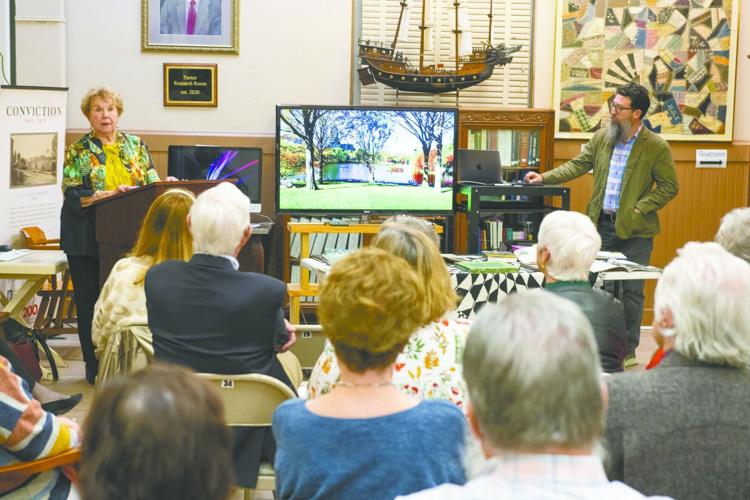No one has to say where Central Park is located.
Far fewer people know the New York City park was originally designed by Frederick Law Olmsted and Calvert Vaux in the 1850s to provide a rural escape from city life.
Even fewer know Titus native Bruce Kelly was the landscape architect who, along with a small group of people, brought the park out of disrepair in the early 1980s.
Kelly’s sister Phyllis Kennedy told the story of the park’s history during a presentation at the Elmore County History Museum Sunday.
“By the mid-1800s people were really getting restless,” Kennedy said. “On Sundays, they were found in New York crowding into any open space that they could find, particularly cemeteries. Greenwood Cemetery in Brooklyn was covered up with people every Sunday and everything was absolutely trampled to the ground.”
Civic leaders found a way to purchase 700 acres of rock, swamp, small farms and settlements and portions of Kingsbridge Road that lies from 59th to 106th streets and between Fifth and Eight avenues. The idea was to create an urban park. It is now more than 800 acres.
Officials held a design competition and selected the plan of Olmsted and Vaux. Their plan was largely inspired by Birkenhead Park in England. They proposed large rural landscapes and wooded areas with roads hidden below.
“After the construction of the park, it literally became an oasis for New Yorkers,” Kennedy said. “It offered some respite from city living. It became the backyard for hundreds of thousands of people. But by the 1960s and 70s, it had fallen into terrible disrepair.”
Kelly was born in Montgomery and raised in Titus until he was 5 years old. The Kelly family was generations deep in the small community of northern Elmore County. Work took the family to Georgia, where Kelly received a landscape architect degree from the University of Georgia. He went to New York to get his master’s degree from Columbia University. But Elmore County was always there.
“We came back to Alabama for every vacation,” Kennedy said. “My parents retired and came back. I came back. Bruce came back.”
Kelly eventually went to Columbia for its historic preservation program under Dr. James Morrison Fitch.
“Bruce developed an added interest in the work of Olmsted,” Kennedy said. “About that time, there was getting to be pretty widespread interest in trying to do something about Central Park.”

Cliff Williams / TPI Phyllis Kennedy, right, shares a laugh with guests after she presented a program about her brother Bruce Kelly at meeting of the Elmore County Historical Society.
City leaders were wanting to restore the park. Fitch had already said the park should retain its Olmsted heritage.
Kelly curated an exhibit for the Metropolitan Museum of Art entitled The Art of the Land of Olmsted landscape.
“He wrote the title essay for the book produced for the exhibit,” Kennedy said. “That book, as much as anything else, established him as an Olmsted scholar, maybe the Olmsted scholar for people to look toward.”
Kelly identified 15 elements that are inherent in any Olmsted landscape.
“That was way more definition than anybody had ever given to that subject before,” Kennedy said. “Every vista had been conceived to have all the elements of a beautiful picture.”
Kelly’s work was recognized by Landscape Architecture magazine.
As the park was falling into disrepair, funding came from an unlikely source.
John Lennon and Yoko Ono were well known for their walks through Central Park. After Lennon was shot in 1980, Ono announced she would fund $1 million for a part of the park to memorialize him. Trees, flowers, iron gates, totem poles and mosaic benches were sent from around the world to be part of the memorial.
Ono had a part in selecting the designer, and ultimately chose Kelly, who went to work to bring Strawberry Fields alive. It was 3 acres at one of the most used entrances to Central Park.
“It was previously one of the most dismal parts of the patches of the park,” Kennedy said. “The soil was eroded and compacted. Many trees were dead and the living trees were mainly trash trees with no redeeming attributes. A path of asphalt had been rolled out across the meadow.”
Kelly didn’t use all of the submissions from around the world for the park. Some of what he used had to be made smaller including the main mosaic. It came from a piece more than 40 feet in size.
Now, Strawberry Fields is a spot many New Yorkers and visitors see. It joins Bethesda Terrance and its carriage rides dating back to Central Park’s earliest days.
Strawberry Fields gives everyone a greenspace to use and also has a special bench dedicated to Kelly.
Strawberry Fields was among the first sections of the park to be restored and set the standard for the rest of the Central Park restoration.
“It sparked enthusiasm for the huge project of transforming the whole park,” Kennedy said. “Bruce was responsible for the success, for the successful restoration of Strawberry Fields, which was responsible for the restoration of Central Park.”
Central Park will now have a connection to Titus and Strawberry Fields forever.




